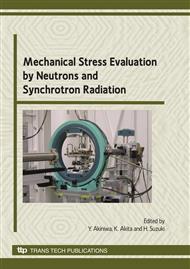p.44
p.50
p.57
p.63
p.70
p.74
p.80
p.86
p.92
Grain Tracking at the High Energy Materials Science Beamline of the Petra III Synchrotron Radiation Source
Abstract:
Grain tracking is a term used to describe experiments that investigate polycrystalline materials in terms of the crystallites or grains from which they are composed, non-destructively and in three dimensions. The new German high brilliance synchrotron radiation source, Petra III, will become available to users in 2010 [1]. The GKSS research centre will operate two beamlines, including the high energy materials science beamline (HEMS) [2]. HEMS will feature an instrument dedicated to grain tracking, able to support a range of experiments of this kind. This paper describes the design and specification of this instrument, and gives examples of the types of experiments that will be possible.
Info:
Periodical:
Pages:
70-73
Citation:
Online since:
May 2010
Keywords:
Price:
Сopyright:
© 2010 Trans Tech Publications Ltd. All Rights Reserved
Share:
Citation:


